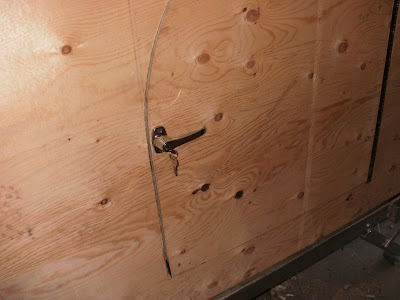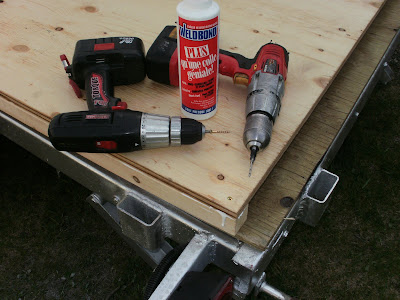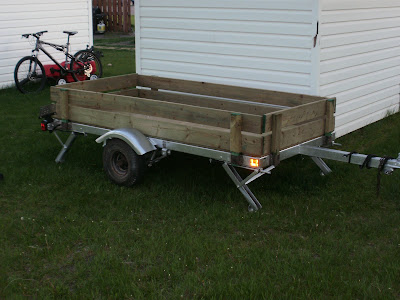





 Well loyal readers, I've been very busy lately and haven't had a chance to give you an update, until now. These photos are actually a couple days old. They show the first coat of interior paint. There is a second coat in now, and I plan to give it a third for good measure. The paint i'm using is Behr Premium Plus or something like that, and it does a fairly good job of covering the stamps on the plywood, which is something I was concerned about.
Well loyal readers, I've been very busy lately and haven't had a chance to give you an update, until now. These photos are actually a couple days old. They show the first coat of interior paint. There is a second coat in now, and I plan to give it a third for good measure. The paint i'm using is Behr Premium Plus or something like that, and it does a fairly good job of covering the stamps on the plywood, which is something I was concerned about.  On the bright side though, I finally started staining the galley tonight. I'm using Minwax Polyshades, which is a 2-in-1 stain and polyurethane treatment. For this first coat, I used it like normal stain, painting it on and then wiping it with a rag. This got the colour into the wood, and for the next coat, I won't use the rag. I'll just brush on a thin coat of the product and then leave it to dry. That should give it the nice high gloss, tough finish that is Polyshades' claim to fame.
On the bright side though, I finally started staining the galley tonight. I'm using Minwax Polyshades, which is a 2-in-1 stain and polyurethane treatment. For this first coat, I used it like normal stain, painting it on and then wiping it with a rag. This got the colour into the wood, and for the next coat, I won't use the rag. I'll just brush on a thin coat of the product and then leave it to dry. That should give it the nice high gloss, tough finish that is Polyshades' claim to fame.  I was taking the card out of the camera to upload the photos from yesterday’s trailer work, when Ella the China Shop Bear jumped up and caused me to drop camera, batteries, SD card and all. She then rooted around the rubble with her nose, and as I gathered up all the dropped bits, I found no trace of the memory card. Even if I could find the damn thing after it’s been through her, I’d be surprised if it’s still functional. Not that I’d be that picky about using an 8GB turd to store my photos.
I was taking the card out of the camera to upload the photos from yesterday’s trailer work, when Ella the China Shop Bear jumped up and caused me to drop camera, batteries, SD card and all. She then rooted around the rubble with her nose, and as I gathered up all the dropped bits, I found no trace of the memory card. Even if I could find the damn thing after it’s been through her, I’d be surprised if it’s still functional. Not that I’d be that picky about using an 8GB turd to store my photos.
 Today was day one of door-a-palooza. I got the passenger side door sorted out, and tomorrow I'll do the driver's side.
Today was day one of door-a-palooza. I got the passenger side door sorted out, and tomorrow I'll do the driver's side. Next came the door latch. In the top photo you can see the interior handle with the latch itself, and in the second photo you can see the exterior handle with the keys hanging out. I couldn't find any decent deals locally for this type of door latches. It would have cost about $80 for all three doors if I had purchased the parts locally, so I ordered them from Vintek. They cost $77 with shipping.
Next came the door latch. In the top photo you can see the interior handle with the latch itself, and in the second photo you can see the exterior handle with the keys hanging out. I couldn't find any decent deals locally for this type of door latches. It would have cost about $80 for all three doors if I had purchased the parts locally, so I ordered them from Vintek. They cost $77 with shipping.
 I carried on with the cabinetry today. I started with the face of the wardrobe, which I cut, test fitted, marked where I wanted holes for the drawer and doors, cut again, adjusted, then installed. I then made the cabinet doors. They were cut 3/4" outside the dimensions of the holes, simply because that was the hinge offset, and I wanted an even border all around for easy measuring. I still need to make a face for the drawer. I may wait until I can get at the router in the base woodshop to make a nice face, If I can't find something else suitable. Yes, I did notice the gap where the roof meets the cabinet. It's not a big deal, I'll be putting some moulding up there anyway.
I carried on with the cabinetry today. I started with the face of the wardrobe, which I cut, test fitted, marked where I wanted holes for the drawer and doors, cut again, adjusted, then installed. I then made the cabinet doors. They were cut 3/4" outside the dimensions of the holes, simply because that was the hinge offset, and I wanted an even border all around for easy measuring. I still need to make a face for the drawer. I may wait until I can get at the router in the base woodshop to make a nice face, If I can't find something else suitable. Yes, I did notice the gap where the roof meets the cabinet. It's not a big deal, I'll be putting some moulding up there anyway. I then put in dividers under the galley counter, and attached a 1/2" plywood door to one side using a scrap bit of piano hinge that I had cut off the galley hatch hinge. The door was warped a bit, so I stuck a piece of 1/2" plywood in the door and screwed it closed in order to take the warp out of it.
I then put in dividers under the galley counter, and attached a 1/2" plywood door to one side using a scrap bit of piano hinge that I had cut off the galley hatch hinge. The door was warped a bit, so I stuck a piece of 1/2" plywood in the door and screwed it closed in order to take the warp out of it.



 Today I kept going on the hatch. Dwayne and I skinned the inside. The hatch isn't square, because the roof beam that holds the hinge isn't square, and I thought that it wouldn't cause much of a problem if I just adjusted the hatch to fit the roof beam. Wrong. I definately should have squared up the beam. The inner skin isn't flush with the hinge edge, which isn't a big deal since that'll be covered with a bit of trim anyway. However, when we tried to skin the outside of the door it was a bit disastrous. I'll have to start with a fresh sheet tomorrow. I'll attach it first at the bottom of the hatch, which is square, and work my way to the top (which is around 1/2" out), and then trim the top to fit along the hinge. Too bad I didn't fix that before it was too late.
Today I kept going on the hatch. Dwayne and I skinned the inside. The hatch isn't square, because the roof beam that holds the hinge isn't square, and I thought that it wouldn't cause much of a problem if I just adjusted the hatch to fit the roof beam. Wrong. I definately should have squared up the beam. The inner skin isn't flush with the hinge edge, which isn't a big deal since that'll be covered with a bit of trim anyway. However, when we tried to skin the outside of the door it was a bit disastrous. I'll have to start with a fresh sheet tomorrow. I'll attach it first at the bottom of the hatch, which is square, and work my way to the top (which is around 1/2" out), and then trim the top to fit along the hinge. Too bad I didn't fix that before it was too late. After skinning the inside of the hatch, I finished off all the insulation. I managed to do the whole trailer using the partial sheets of polystyrene that Dwayne had lying around, and didn't even have to break into one of his full sheets. If you look closely, you'll see there's a wire dangling down near the tongue. Dwayne suggested that, even though I don't plan on wiring up any 12V electrical, it might be a good idea to run wires through the walls anyway, just in case I feel like hooking something up later. It only took about 10 minutes to run some wires along the frame, and it's nice to know that I have the option. I marked several spots on the inside where I could drill through the ceiling and get at the harness, just guessing at likely spots where I might want lights, fans, plugs etc. later.
After skinning the inside of the hatch, I finished off all the insulation. I managed to do the whole trailer using the partial sheets of polystyrene that Dwayne had lying around, and didn't even have to break into one of his full sheets. If you look closely, you'll see there's a wire dangling down near the tongue. Dwayne suggested that, even though I don't plan on wiring up any 12V electrical, it might be a good idea to run wires through the walls anyway, just in case I feel like hooking something up later. It only took about 10 minutes to run some wires along the frame, and it's nice to know that I have the option. I marked several spots on the inside where I could drill through the ceiling and get at the harness, just guessing at likely spots where I might want lights, fans, plugs etc. later. The curves had fairly big gaps in the insulation, because I didn't feel like mitering the polystyrene to fit precisely. Luckily I planned for this and bought a can of spray-in foam insulation. I filled in all the gaps with it, and dang, is that ever messy stuff. I'll be scrubbing my hands for quite awhile trying to get rid of it.
The curves had fairly big gaps in the insulation, because I didn't feel like mitering the polystyrene to fit precisely. Luckily I planned for this and bought a can of spray-in foam insulation. I filled in all the gaps with it, and dang, is that ever messy stuff. I'll be scrubbing my hands for quite awhile trying to get rid of it.
 I then clamped all 7 together and sanded the edges so that they were even.
I then clamped all 7 together and sanded the edges so that they were even.I figured out how to enable comments on the blog, so you can now leave comments at the bottom of the page, or click where it says "comments" to leave them.
I also discovered that I can email posts from my Blackberry (and thus, straight from the jobsite). So you'll now be kept more up-to-date than ever before.
Sent from my BlackBerry device on the Rogers Wireless Network

I started off the day by marking and cutting out the doors. As you can see, I kept the same rounded profile as the generic benroy plans from the first post of this blog. The curve on the door is a 19"radius, the same as the front curve on the roof.
I'll answer the question before you ask it: Why yes, that is me cutting into a plywood wall using an angle grinder. I wanted something that would cut a narrow, linear hole to start the jigsaw blade. I'll be using the same pieces of plywood I cut out as the actual doors, so I didn't want any big round gouges in them to leak. The cutoff wheel on the angle grinder worked very well, despite making a lot of smoke.

Next on the docket was framing the roof vent I picked up this afternoon at Canadian Tire. This was fairly straightforward.

The plywood walls were warped a bit, and not sitting plum at the front. They also weren't as stiff as I would have liked, so I put in some diagonal braces. I had to give myself a refresher trigonometry lesson to get the angles right, but they fit like a glove. They also brought the whole thing back to plum, and made it stiff as hell.
I carried on with the remainder of the roof beams, and added a couple along the centreline running fore-aft.

As darkness fell, I enlisted the help of Nathan (Dwayne's son) and his friend. The extra hands were helpful jamming the masonite headliner into position. As it turned out, the top of the roof was about 47 15/16" rather than a full 48, so it was a very snug fit, and the masonite held itself up. screwing it to the roof beams proved to be a pain in the rectum, as the screws don't seem to have quite as broad a head on them as the masonite would prefer. Regardless, I got it in before Wayner called to invite me to go find a brand spanking new geocache with him.

Sorry about the poor quality photos of the headliner. It was dark, the camera flash wasn't cooperating, and I was in a hurry to go geocaching.
Tomorrow I plan to lay a good thick bead of glue between all the roof braces and the headliner, because the screws could potentially wear through the sheet.

The 4x8 sheet just happened to go all the way to the back of the cabin. Handy. It's almost like I'd planned it that way.

 After taking a short break to go for a nice drive (see below), I installed the lower bulkhead. I became a yardstick for this step, using my own length to determine the amount of galley space I could have. I laid on the floor and stretched out to see how far aft I would need to go with the bulkhead.
After taking a short break to go for a nice drive (see below), I installed the lower bulkhead. I became a yardstick for this step, using my own length to determine the amount of galley space I could have. I laid on the floor and stretched out to see how far aft I would need to go with the bulkhead. 
 I then went to Heavy Pedal Ranch while everyone was away at school/work and started cutting and welding on the pieces of box beam for the stake pockets. I initially welded just the two sides of each, but Dwayne came home and suggested I weld across the top to keep moisture out from between the pieces, so they wouldn't start to rust out as quickly. As you can see, my welding doesn't suck quite as bad is it did.
I then went to Heavy Pedal Ranch while everyone was away at school/work and started cutting and welding on the pieces of box beam for the stake pockets. I initially welded just the two sides of each, but Dwayne came home and suggested I weld across the top to keep moisture out from between the pieces, so they wouldn't start to rust out as quickly. As you can see, my welding doesn't suck quite as bad is it did.
